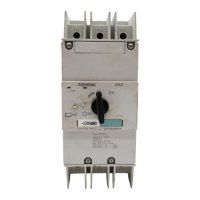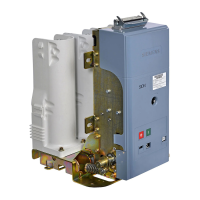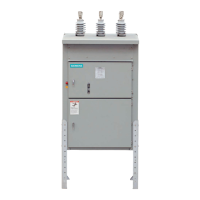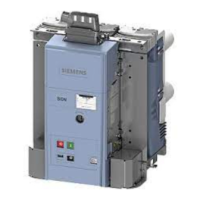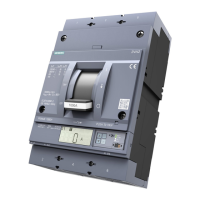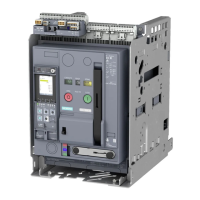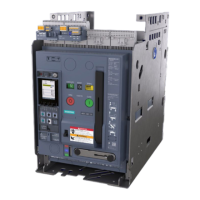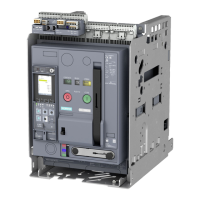Do you have a question about the Siemens Static Trip III and is the answer not in the manual?
Crucial safety warnings regarding hazardous voltages, injury, and equipment damage.
Disclaimer about information being general, user responsibility, and Siemens' right to make changes.
Defines "Authorized and qualified personnel" by detailing specific training and authorization requirements.
States instructions do not cover all variations and refers users to local sales offices.
Overview of Static Trip III trip units, their features, and models.
Describes the six basic overcurrent protection configurations and their features.
Explains the custom liquid crystal display (LCD) for indicating overcurrent tripping actions.
Details the capabilities of Static Trip IIIC/CP/CPX for metering and communication.
Explains the additional protective relaying functions available with IIICPX trip units.
Lists protective relay functions with pickup setting and time delay ranges.
Describes logging functions for recording tripping events, pickups, and measured values.
Details the standard alarm output feature and its use for signaling.
Explains how trip units can be wired to open or close circuit breakers remotely.
Describes the functional block diagrams for Static Trip III and IIIC/CP/CPX trip units.
Explains how users control the trip unit via adjustments and programming.
Describes the special purpose toroidal current sensors used for fault protection and metering.
Details the process for overcurrent fault protection and tripping.
Explains the function and operation of the tripping actuator mechanism.
Explains the requirement for external 15V dc control power for the communications microprocessor.
Describes the special purpose potential transformer assembly for voltage signals and isolation.
Explains the BDU accessory for local monitoring and programming of trip units.
Details optically isolated inputs/outputs for breaker position and alarm/close signals.
Describes the shadow protection feature provided by the communications microprocessor.
Details the process for removing and replacing the transparent cover for adjustments.
Explains how to set overcurrent protection adjustments using the switches.
Illustrates the time-current curve regions affected by each adjustment.
Explains how the long time setting establishes the maximum current level for continuous operation.
Describes how the long time delay sets the tripping delay based on overcurrent magnitude.
Explains the "Thermal Memory" function to protect against persistent intermittent overcurrents.
Explains how the short time pickup sets the high current level for short periods.
Describes how the short time delay sets the tripping delay in response to overcurrent.
Explains how the instantaneous pickup sets the trip level without intentional delay.
Explains how the ground fault pickup sets the level of ground current for interruption.
Describes how the ground fault delay sets the tripping delay in response to ground current.
Explains the ground fault memory circuit that integrates ground fault currents with time.
Provides instructions for constructing a time-current curve for fault protection.
Lists metered parameters and their specifications.
Provides detailed specifications for measured parameters like phase currents and voltages.
Explains the sign conventions for real and reactive power flow.
Describes the 7 available extended protective relaying functions.
Details the Current Unbalance protective relay function, settings, and data recorded.
Explains the Voltage Unbalance protective relay function and its parameters.
Details the Under Voltage protective relay function and its programmable settings.
Describes the Over Voltage protective relay function and its programmable settings.
Explains the Under Frequency protective relay function and its programmable settings.
Details the Over Frequency protective relay function and its programmable settings.
Details the Reverse Power protective relay function and its programmable settings.
Explains the trip log which records the last 3 tripping events and stored parameters.
Describes the available alarm functions and their operating modes.
Describes alarms for measured parameters exceeding programmed thresholds.
Describes alarms for measured parameters falling below programmed thresholds.
Details unbalance alarms for phase current or voltage compared to average.
Explains the unique Power Factor alarm function with two pickup ranges.
Discusses recalibration of metering functions and factory programming.
Explains password protection for changing configuration and set-points.
Describes using the RS-485 port for remote monitoring and programming.
Details local monitoring and programming using a PC or BDU.
Provides default values for fundamental configuration parameters and their sources.
Details the pin-outs and functions of the 10-position rear connector.
Details the pin-outs and functions of the 4-position rear connector.
Explains CRC checks for data integrity and error flag detection.
Overview of field testing methods for Static Trip III trip devices.
Describes secondary current testing using the PTS4 portable test set.
Details the procedure for testing the short time pickup function.
Explains how to test the instantaneous trip element by tripping the breaker.
Describes the test for ground fault pickup settings using the PTS4.
Details the procedure for testing the long time delay function.
Explains how to test the short time delay bands.
Describes testing the ground time delay bands.
Details how to test the zone interlocking functionality.
Describes testing the load indicator output signal with a binary word.
Explains how to test the tripping actuator for proper operation.
Discusses testing current sensors for proper performance.
Describes checking sensor secondary windings and wiring for continuity.
Explains testing for shorted turns in current sensor windings using AC voltage.
Discusses checking sensor polarity for proper ground fault detection.
Details testing with primary current, including challenges and procedures.
Explains the two BDU operating modes: data and program.
Illustrates the automatic and manual scrolling sequence in data mode.
Describes how to read real-time metered values using the BDU.
Explains how to read maximum and minimum parameter values.
Details how to read alarm log events from the BDU.
Describes how to read trip log events from the BDU.
Details the procedure for entering the password to access configuration.
Explains the process for changing the password.
Shows how to view kW Demand interval settings.
Illustrates viewing alarm parameter and set-point configurations.
Details how to view trip configuration parameters and set-points.
Explains how to change configuration parameters and set-points.
Demonstrates changing alarm set-points.
Explains how to clear min/max values and energy registers.
Describes how to adjust the LED display brightness.
Details the BDU self-test feature for checking operation and software.
Summarizes BDU error messages and their causes.
Describes zone interlock expanders and couplers for connecting trip units.
Details the two models of zone interlock expanders for upstream/downstream connections.
Explains the zone interlock coupler for connecting single trip units.
Discusses external 15V DC power supplies for communication microprocessors and BDUs.
Describes the disconnect assembly for communications, power, and alarm signals.
Details the PTS4 portable test set for testing trip units and actuators.
Explains the spring-loaded switch for breaker open/closed position input.
Describes the interposing relay for integrating trip unit output signals.
Details the two models of potential transformer modules for power metering.
Explains the 11-digit part number structure for Static Trip III units.
Lists part numbers based on overcurrent functions and communications.
Explains the part number structure for retrofit version Static Trip III units.
Lists part numbers for retrofit units based on functions.
Defines the letters used in the Static Trip III trip unit catalog number.
Crucial safety warnings regarding hazardous voltages, injury, and equipment damage.
Disclaimer about information being general, user responsibility, and Siemens' right to make changes.
Defines "Authorized and qualified personnel" by detailing specific training and authorization requirements.
States instructions do not cover all variations and refers users to local sales offices.
Overview of Static Trip III trip units, their features, and models.
Describes the six basic overcurrent protection configurations and their features.
Explains the custom liquid crystal display (LCD) for indicating overcurrent tripping actions.
Details the capabilities of Static Trip IIIC/CP/CPX for metering and communication.
Explains the additional protective relaying functions available with IIICPX trip units.
Lists protective relay functions with pickup setting and time delay ranges.
Describes logging functions for recording tripping events, pickups, and measured values.
Details the standard alarm output feature and its use for signaling.
Explains how trip units can be wired to open or close circuit breakers remotely.
Describes the functional block diagrams for Static Trip III and IIIC/CP/CPX trip units.
Explains how users control the trip unit via adjustments and programming.
Describes the special purpose toroidal current sensors used for fault protection and metering.
Details the process for overcurrent fault protection and tripping.
Explains the function and operation of the tripping actuator mechanism.
Explains the requirement for external 15V dc control power for the communications microprocessor.
Describes the special purpose potential transformer assembly for voltage signals and isolation.
Explains the BDU accessory for local monitoring and programming of trip units.
Details optically isolated inputs/outputs for breaker position and alarm/close signals.
Describes the shadow protection feature provided by the communications microprocessor.
Details the process for removing and replacing the transparent cover for adjustments.
Explains how to set overcurrent protection adjustments using the switches.
Illustrates the time-current curve regions affected by each adjustment.
Explains how the long time setting establishes the maximum current level for continuous operation.
Describes how the long time delay sets the tripping delay based on overcurrent magnitude.
Explains the "Thermal Memory" function to protect against persistent intermittent overcurrents.
Explains how the short time pickup sets the high current level for short periods.
Describes how the short time delay sets the tripping delay in response to overcurrent.
Explains how the instantaneous pickup sets the trip level without intentional delay.
Explains how the ground fault pickup sets the level of ground current for interruption.
Describes how the ground fault delay sets the tripping delay in response to ground current.
Explains the ground fault memory circuit that integrates ground fault currents with time.
Provides instructions for constructing a time-current curve for fault protection.
Lists metered parameters and their specifications.
Provides detailed specifications for measured parameters like phase currents and voltages.
Explains the sign conventions for real and reactive power flow.
Describes the 7 available extended protective relaying functions.
Details the Current Unbalance protective relay function, settings, and data recorded.
Explains the Voltage Unbalance protective relay function and its parameters.
Details the Under Voltage protective relay function and its programmable settings.
Describes the Over Voltage protective relay function and its programmable settings.
Explains the Under Frequency protective relay function and its programmable settings.
Details the Over Frequency protective relay function and its programmable settings.
Details the Reverse Power protective relay function and its programmable settings.
Explains the trip log which records the last 3 tripping events and stored parameters.
Describes the available alarm functions and their operating modes.
Describes alarms for measured parameters exceeding programmed thresholds.
Describes alarms for measured parameters falling below programmed thresholds.
Details unbalance alarms for phase current or voltage compared to average.
Explains the unique Power Factor alarm function with two pickup ranges.
Discusses recalibration of metering functions and factory programming.
Explains password protection for changing configuration and set-points.
Describes using the RS-485 port for remote monitoring and programming.
Details local monitoring and programming using a PC or BDU.
Provides default values for fundamental configuration parameters and their sources.
Details the pin-outs and functions of the 10-position rear connector.
Details the pin-outs and functions of the 4-position rear connector.
Explains CRC checks for data integrity and error flag detection.
Overview of field testing methods for Static Trip III trip devices.
Describes secondary current testing using the PTS4 portable test set.
Details the procedure for testing the short time pickup function.
Explains how to test the instantaneous trip element by tripping the breaker.
Describes the test for ground fault pickup settings using the PTS4.
Details the procedure for testing the long time delay function.
Explains how to test the short time delay bands.
Describes testing the ground time delay bands.
Details how to test the zone interlocking functionality.
Describes testing the load indicator output signal with a binary word.
Explains how to test the tripping actuator for proper operation.
Discusses testing current sensors for proper performance.
Describes checking sensor secondary windings and wiring for continuity.
Explains testing for shorted turns in current sensor windings using AC voltage.
Discusses checking sensor polarity for proper ground fault detection.
Details testing with primary current, including challenges and procedures.
Explains the two BDU operating modes: data and program.
Illustrates the automatic and manual scrolling sequence in data mode.
Describes how to read real-time metered values using the BDU.
Explains how to read maximum and minimum parameter values.
Details how to read alarm log events from the BDU.
Describes how to read trip log events from the BDU.
Details the procedure for entering the password to access configuration.
Explains the process for changing the password.
Shows how to view kW Demand interval settings.
Illustrates viewing alarm parameter and set-point configurations.
Details how to view trip configuration parameters and set-points.
Explains how to change configuration parameters and set-points.
Demonstrates changing alarm set-points.
Explains how to clear min/max values and energy registers.
Describes how to adjust the LED display brightness.
Details the BDU self-test feature for checking operation and software.
Summarizes BDU error messages and their causes.
Describes zone interlock expanders and couplers for connecting trip units.
Details the two models of zone interlock expanders for upstream/downstream connections.
Explains the zone interlock coupler for connecting single trip units.
Discusses external 15V DC power supplies for communication microprocessors and BDUs.
Describes the disconnect assembly for communications, power, and alarm signals.
Details the PTS4 portable test set for testing trip units and actuators.
Explains the spring-loaded switch for breaker open/closed position input.
Describes the interposing relay for integrating trip unit output signals.
Details the two models of potential transformer modules for power metering.
Explains the 11-digit part number structure for Static Trip III units.
Lists part numbers based on overcurrent functions and communications.
Explains the part number structure for retrofit version Static Trip III units.
Lists part numbers for retrofit units based on functions.
Defines the letters used in the Static Trip III trip unit catalog number.
| Brand | Siemens |
|---|---|
| Model | Static Trip III |
| Category | Circuit breakers |
| Language | English |
